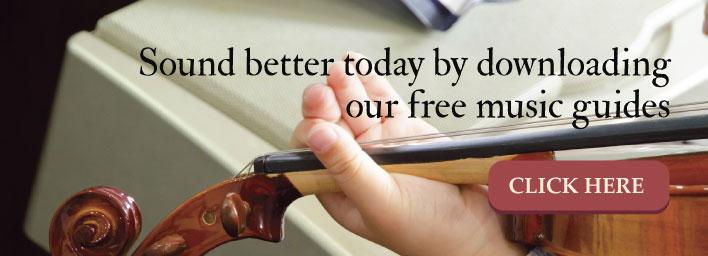
As a student of the violin, there are a variety of initial steps you must take to become proficient. And, if you are new to music theory in general, each foundational concept that you learn and master builds the groundwork for the next new technique.
Most students immediately recognize that music is filled with a variety of note symbols that represent not only a certain pitch, but also a certain measure of time. Creating those notes on the violin takes practice, but once you’ve developed proficiency with quarter notes (and possibly eighth notes), learning to play half notes on the violin is the next logical progression. This basic guide can help you learn how to play half notes, and how to incorporate them into the music.
Talking Time
At this point, you should have a basic understanding of time signature and how it dictates the music you’re reading. Beginner musicians almost always start by learning common (4/4) time. The top number represents the number of downbeats contained in each measure (bar), and the bottom number tells you which note is worth one of the downbeats. In common time, this means that there are four beats per measure, and the quarter note gets one beat. A simple clap and count exercise can help demonstrate:
Count silently or out loud “one and two and three and four and.” On each number, clap. The clap (if the sound could be held for the full number and the “and,”) is a quarter note.
Using the same count, now clap on each number and on each “and.” These claps are eighth notes. Simple, right?
Since you’re probably familiar with playing both quarter notes and eighth notes, you can use that knowledge to develop further. Half notes are only slightly different; instead of more notes per measure, you’ll have half as many.
Half Note Practice
Using the clapping exercise from above, this time, only clap when you say the first and third downbeat. Although the clapping sound won’t extend to cover both beats like a played note will, doing this simple exercise helps you recognize where half notes occur in the rhythm.
Playing a half note on the violin means holding that particular sound for a full two beats (in common time). The sound should be constant over the entire interval.
Practice bowing an open A, using the same bow that you would normally use for playing two quarter notes. This will require that you sustain the bow movement slightly to ensure that you play a full two beats.
At this point, it’s actually beneficial to work on slowing down your bow motion. To be able to play half notes, and eventually whole notes (that last for four beats in common time), you’ll need make sure that you can extend the sound you create by keeping your bow straight and in constant motion.
Practice playing this simple exercise.
You’ll notice that it will take some practice making sure that you hold the sound for a full two beats.
Other Tips and Strategies
Some things to keep in mind while you’re learning to play half notes include:
- Work on extending your bow stroke, rather than speeding up the tempo.
- Focus on creating clear distinctions between note intervals (you don’t want the exercise to sound like one giant blob).
- Challenge yourself by alternating between quarter note A’s and half notes with other open strings, or by alternating A’s and D’s.
Since half notes are twice as long as quarters (in common time), learning to incorporate them into a rhythm isn’t too difficult. The main challenge will lie in extending your bow stroke to ensure that you’re holding the sound for the proper length. So be sure to practice your straight bow and really focus on keeping it correct. If you do that, learning to play half notes will take you half the time.

